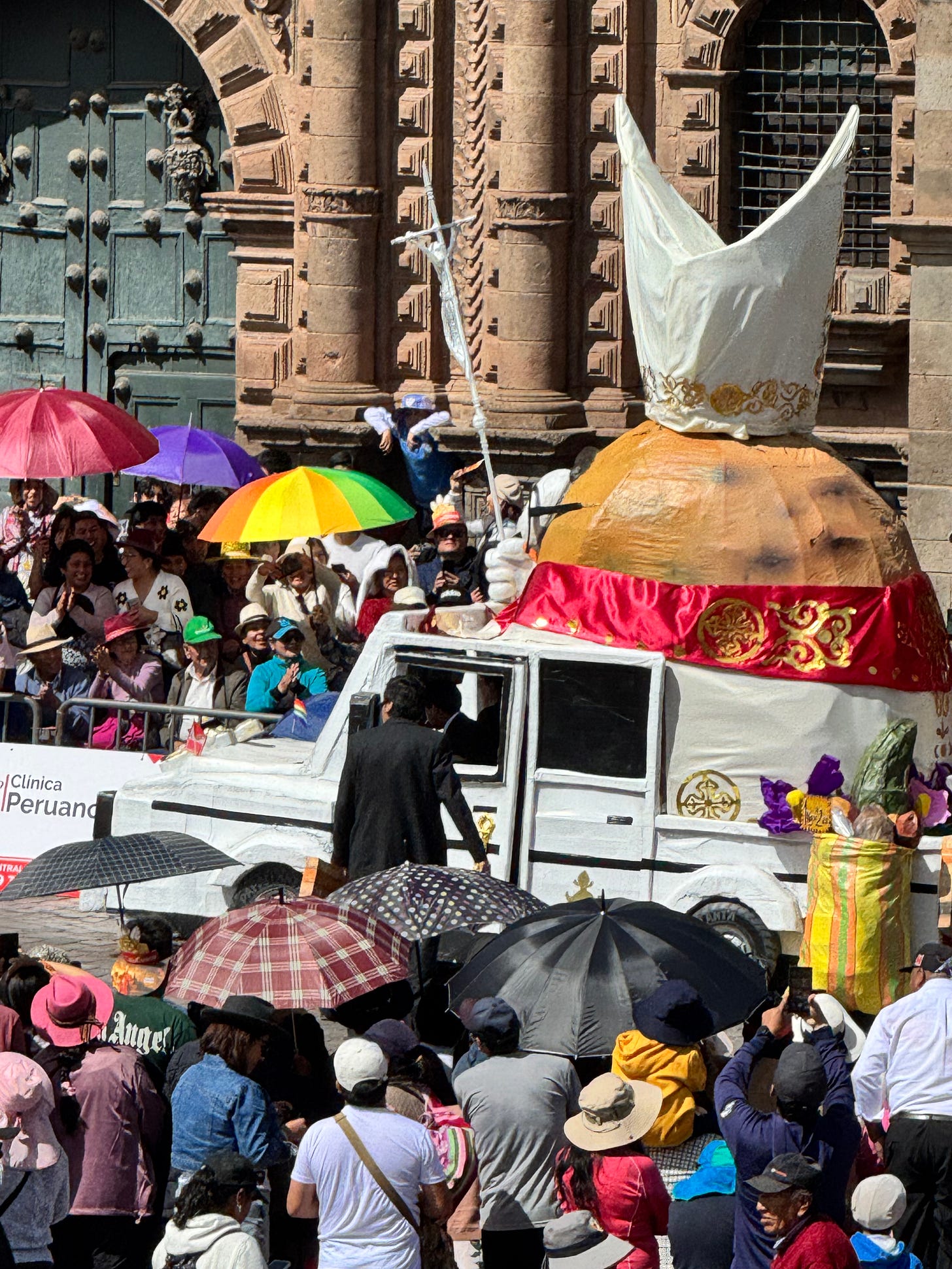I skipped church today.
I traded a pew for a seat in a café on a balcony overlooking the Plaza de Armas, the main square in Cusco. Instead of a hymn book, I have a café americano and a delicious cinnamon roll.
The sun is hot, but I’m seated comfortably on a plush stool at a small table, squeezed into a shady corner. Today is another desfile—a parade. These people love their public parties! But it is June, a month of many celebrations. Judging by the packed stadium seating erected just for the day, not many others are in church either.
The sunlight at this altitude is no joke. Though it’s only 63°F, it feels more like 90° on a beach in full sun. I notice many people in hats, but very few wearing sunglasses. The entrepreneur in me imagines a sidewalk stall selling shades in colors to match the brilliant costumes in the parade.
The Pope and the Potato
Today’s main attraction is a parade of floats from various university art departments. My hometown of Starkville could take a few lessons in creative float design.
My favorite? A float that interpreted the new pope. He has dual citizenship with both the United States and Peru and is beloved in Cusco, a predominantly Catholic city. Across the world, the pope is lovingly called Papa—meaning “father”—but papa also means “potato” in Spanish.
So what did they do?
They built a “pope mobile” float featuring a giant potato as the pope, complete with a papal mitre.
Above: A papal float in Cusco’s university parade features a giant “papa” (potato) crowned with a mitre—a clever nod to both the Pope and the Spanish word for potato.
Creative. Hilarious. So Cusco.
Streets Alive with Motion and Color
Despite its ancient roots, Cusco today is anything but sleepy. It’s a city alive with motion, sound, and striking contrasts.
The streets around the Plaza are a constant buzz of activity: taxis dart between buses, horns blare, and pedestrians weave through tight gaps. Cars and people share the narrow cobblestone roads in a kind of organized chaos.
And the people—a wonderful mix of generations. Grandparents walk with grandchildren and great-grandchildren tagging along. So many are young, bright-eyed, and vibrant. Students in uniform—black trousers, black shoes, pale shirts—add their own flair with vivid ponchos draped over their shoulders. They look like blossoms balanced atop tall stems, their colors a striking contrast against their beautiful brown skin and black hair.
Shops line every corner of the plaza, except where the imposing Basilica stands. Each shop offers a glimpse into local culture. Down the side streets, upscale boutiques cater to tourists, but I skip one candy shop when I remember a cheaper one just a block away. Alpaca wool is everywhere—vivid reds, oranges, and blues for locals; muted tones for travelers hoping to bring home a piece of Peru.
A Few Steps, A Small Everest
I’m here for language school—at a place called Máximo Nivel. Getting there requires a crowded bus ride and, once off, just a few steps and a few stairs. But at over 11,000 feet above sea level, those stairs feel like a small Everest.
I find myself winded, plodding up like the old man at the beach trying to hold in his stomach while the flat-bellied locals breeze past. Still, my bald head and grey beard seem to earn a little respect.
Even in the shortness of breath, there’s a fullness to the experience.
Modern Cusco is vibrant, challenging, and alive—just like the people who call it home.



This post has a lot of funny in it! Cracked me up about the pope and the potato. But also the honesty in the stairs being everest! So glad you are journaling!